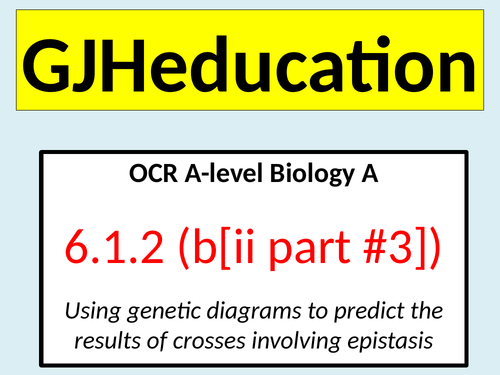



This fully-resourced lesson explores how the presence of particular alleles at one locus can mask the expression of alleles at a second locus in epistasis. The detailed and engaging PowerPoint and associated resources have been designed to cover the part of point 6.1.2 (b[ii]) of the OCR A-level Biology A specification which states that students should be able to demonstrate and apply their knowledge and understanding of the use of phenotypic ratios to identify epistasis.
This is a topic which students tend to find difficult, and therefore the lesson was written to split the topic into small chunks where examples of dominant, recessive and complimentary epistasis are considered, discussed at length and then explained. Understanding checks, in various forms, are included throughout the lesson so that students can assess their progress and any misconceptions are immediately addressed. There are regular links to related topics such as dihybrid inheritance so that students can meet the challenge of interpreting genotypes as well as recognising the different types of epistasis.
Get this resource as part of a bundle and save up to 50%
A bundle is a package of resources grouped together to teach a particular topic, or a series of lessons, in one place.
Module 6.1.2: Patterns of inheritance (OCR A-Level Biology A)
Each of the 13 lessons included in this bundle are fully-resourced and have been designed to cover the content as detailed in module 6.1.2 (Patterns of inheritance) of the OCR A-Level Biology A specification. The specification points that are covered within these lessons include: * The contribution of environmental and genetic factors to phenotypic variation * How sexual reproduction can lead to genetic variation within a species * Genetic diagrams to show patterns of inheritance * The use of phenotypic ratios to identify autosomal and sex linkage and epistasis * Using the chi-squared test * The factors that can affect the evolution of a species * The use of the Hardy-Weinberg principle to calculate allele frequencies * The role of isolating mechanisms in the evolution of a new species The lessons have been written to include a wide range of activities and numerous understanding and prior knowledge checks so students can assess their progress against the current topic as well as be challenged to make links to other topics within this module and earlier modules.
Genetic diagrams and phenotypic ratios (OCR A-level Biology A module 6.1.2 [b])
Each of the 6 lessons within this bundle are fully-resourced and cover the content of point (b) of module 6.1.2 of the OCR A-level Biology A specification which states that students should be able to use genetic diagrams and phenotypic ratios to show patterns of inheritance and explain linkage and epistasis. Students are guided through the construction of the genetic diagrams for the inheritance of one or two genes and are shown how to analyse the phenotypic ratio to determine whether linkage has occurred or whether a gene interaction is involved. The wide range of activities which includes exam questions with visual mark schemes, differentiated tasks and quiz competitions will maintain engagement whilst providing the students with opportunities to assess their progress against the current topic.
Something went wrong, please try again later.
Good guide through the different types of epistasis.
Report this resourceto let us know if it violates our terms and conditions.
Our customer service team will review your report and will be in touch.